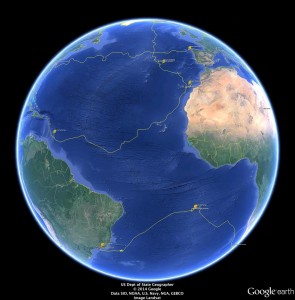Hey All,
Today I finally made some progress, creating a map of the RTOFS data at depth, allowing us to see the sub surface currents that dictate the forces behind Challenger’s movements.

This now lands us with 3 road maps, all providing us with a various views into the depths of the oceans.

In the image above, HyCOM (the bulkier vectors), RTOFS (blue vectors) and myocean (red vectors) all show a strong flow to the north at depth (300m is shown) with various tendencies following depending on which model you refer to. Seeing this consistency is remarkable, however Challenger’s depth average currents are in disagreement, showing a current flowing strong to the south east, following the trend seen since we left the South African Shelf of an overall flow to the east.

It is possible that this is simply due to a lack of data fueling the models as there is a large gap in the locations of the drifters in the area. Speaking with Antonio today, he provided us with a very interesting theory. Pointing out that since we left the shelf and started flying deep, we have seen currents flowing in some way to the east, Antonio suggested that this may be a replenishment of the upwelling zone that covers most of the western coast of Africa. The logic behind the theory is that the water coming up to the surface does flow from the west to the east sub surface before rising up along the shelf. It could be possible that this is the eastward flow Challenger has been seeing.
We also hypothesize that this flow will be broken up by the line of sea mounts that lay ahead of us:

But getting to this line has become an issue.
As I have mentioned previously, Challenger has been performing sub par since we have regained contact after the no coms from May 15-25. Since then the glider has been much more sporadic in her flying and much slower as well. Because of this, our testing continues as we try and diagnose the problem and see what we have to work with and from there extrapolating the data to see what our options are over the next few months.
From our daily glider meeting, we made a time line of tests to run on the next three surfacings. For the surfacing that occurred just moments ago, we increased the data being pulled from the sbd files during file transfer to confirm that by flying in low power mode, the science computer is fully turning on and off as we think. This is an important question for us to determine how much battery power we have to work with. Chip also told Challenger to collect data on both the down and up casts on the CTD that way we can confirm it is working properly after our 10 days at the surface. Finally, we increased the pitch angle to 30˚ in an attempt to increase our velocity.
For tomorrow’s surfacing, we plan on turning the CTD completely off to get a better feel on how much power the increased pitch angle will actually draw over a 3 yo segment. And then on the following segment, we will increase the pitch further to an angle of 35˚ to see what effects that has on our speed and battery power. This issue has become more daunting as we get a better handle on the velocities Challenger has been hitting along with the remaining battery power. With our decrease in speed and the projected further rate of decay, it is looking like it may take us upwards of 145 days to reach Ascension. With only having roughly 180 days of battery left, there are some big decisions headed our way.
Finally the last alteration we made was that we added a new way point to Challengers repertoire. Over the past day, the currents had rotated a bit to the south east, resulting in a flow that was contradicting our attempt at progress in nearly the opposite direction. So after a discussion with Scott, we moved the way point a bit to the south, hoping to cause less of a struggle against the current, but also to keep our options open.

We are just about 600 km from St Helena. So as we continue our tests to asses the state of our glider, we figured it would be wise to keep this island in mind as a last resort if it turns out that it is too risky to push onwards. From there, we may even do a short mission as we did with Silbo’s run from the Azores to the Canary Islands, taking Challenger with a pack of alkaline batteries (much more easily transported than lithiums) and continuing our flight to Ascension.
In other news, Silbo is continuing to drift at the surface as we weigh our options for a recovery mission for the poor guy

Since blowing his weight and becoming a drifter on May 19, Silbo has made roughly 100 km progress westward. Now just 1280 km from Barbados, we can only hope he can continue to drift towards the islands where it will be much easier to conduct an emergency rescue.
Force Wind Sea & Honor
































